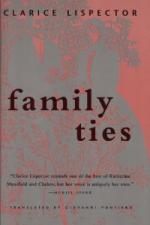|
This section contains 260 words (approx. 1 page at 400 words per page) |

|
Family Ties Summary & Study Guide Description
Family Ties Summary & Study Guide includes comprehensive information and analysis to help you understand the book. This study guide contains the following sections:
This detailed literature summary also contains Bibliography on Family Ties by Clarice Lispector.
"Family Ties" is the title story of Clarice Lispector's Lacos de Familia (Family Ties ). A play on the word "ties" suggests the tension of the story, between the ties that connect and the ties that bind one to family members. Like many of the other stories in the collection, "Family Ties" concerns men and women who, when faced with a moment of epiphany in their relations with others, tragically choose not to communicate openly, but to perpetuate a sense of alienation within family bonds. The story concerns a woman, Catherine, who is relieved when her mother departs after a visit, because their relationship is strained and artificial. They cannot reach each other emotionally and fear doing so. They ignore the deepest part of their feelings for each other, since both hate and love reside there. Almost in retaliation for her own imprisonment, Catherine begins the process of re-creating the same bonds with her young son at the end of the story. She has learned the nature of her anguish from a moment of epiphany, yet rather than right this wrong, she commits it to her son's legacy. The phenomenological narrative style of the story was a landmark in Brazilian literature, opening the door to experimentation with form and language. Clarice Lispector's fiction spans the modern and postmodern eras, representing the human mind in an eloquent and fluid style and probing metaphysical questions of being, identity, and language. This is a story that does not preach, but that exposes essential and tragic human qualities in a quiet, haunting way.
Read more from the Study Guide
|
This section contains 260 words (approx. 1 page at 400 words per page) |

|



